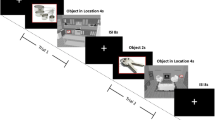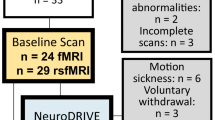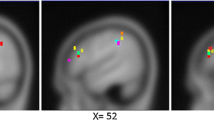Abstract
The cognitive constructs working memory (WM) and processing speed are fundamental components to general intellectual functioning in humans and highly susceptible to disruption following neurological insult. Much of the work to date examining speeded working memory deficits in clinical samples using functional imaging has demonstrated recruitment of network areas including prefrontal cortex (PFC) and anterior cingulate cortex (ACC). What remains unclear is the nature of this neural recruitment. The goal of this study was to isolate the neural networks distinct from those evident in healthy adults and to determine if reaction time (RT) reliably predicts observable between-group differences. The current data indicate that much of the neural recruitment in TBI during a speeded visual scanning task is positively correlated with RT. These data indicate that recruitment in PFC during tasks of rapid information processing are at least partially attributable to normal recruitment of PFC support resources during slowed task processing.



Similar content being viewed by others
Notes
Fixed-effects analyses were conducted in SPM5 comparing the TBI subsamples (n = 6, n = 6) using FDR, p < .05 and no differences were noted. When using a liberal threshold to increase sensitivity to possible differences (p < .001, uncorrected, no cluster threshold), this analysis revealed only small differences between TBI subgroups including clusters in: 1) left middle frontal gyrus (BA9) at −34 42 34 (cluster extent 2 voxels), and right supplementary motor cortex (BA 8) at 32 32 48 (cluster extent 67 voxels), and a cluster of 17 voxels in the left medial inferior parietal lobule (BA 31) at −2 −54 32. These subtle differences do not account for the between-group differences observed here when comparing TBI and HC samples.
References
Ashburner, J., Neelin, P., Collins, D. L., Evans, A., & Friston, K. (1997). Incorporating prior knowledge into image registration. Neuroimage, 6(4), 344–352.
Bradley, V. A., Welch, J. L., & Dick, D. J. (1989). Visuospatial working memory in Parkinson’s disease. Journal of Neurology, Neurosurgery and Psychiatry, 52(11), 1228–1235.
Brandt, J. (1991). The Hopkins Verbal Learning Test (HVLT): development of a new memory test with six equivalent forms. Clinical Neuropsychologist, 5, 125–142.
Bigler, E. D. (2001). Quantitative magnetic resonance imaging in traumatic brain injury. Journal of Head Trauma Rehabilitation, 16(2), 117–34.
Buki, A., & Povlishock, J. T. (2006). All roads lead to disconnection?—Traumatic axonal injury revisited. Acta Neurochir (Wien), 148(2), 181–193. discussion 193–184.
Calhoun, V. D., Stevens, M. C., Pearlson, G. D., & Kiehl, K. A. (2004). fMRI analysis with the general linear model: removal of latency-induced amplitude bias by incorporation of hemodynamic derivative terms. NeuroImage, 22(1), 252-257.
Chang, L., Speck, O., Miller, E. N., Braun, J., Jovicich, J., Koch, C., et al. (2001). Neural correlates of attention and working memory deficits in HIV patients. Neurology, 57(6), 1001–1007.
Chang, L., Tomasi, D., Yakupov, R., Lozar, C., Arnold, S., Caparelli, E., et al. (2004). Adaptation of the attention network in human immunodeficiency virus brain injury. Annals of Neurology, 56(2), 259–272.
Chiaravalloti, N., Hillary, F., Ricker, J., Christodoulou, C., Kalnin, A., Liu, W. C., et al. (2005). Cerebral activation patterns during working memory performance in multiple sclerosis using FMRI. Journal of Clinical and Experimental Neuropsychology, 27(1), 33–54.
Christodoulou, C., DeLuca, J., Ricker, J. H., Madigan, N. K., Bly, B. M., Lange, G., et al. (2001). Functional magnetic resonance imaging of working memory impairment after traumatic brain injury. Journal of Neurology, Neurosurgery and Psychiatry, 71(2), 161–168.
Cohen, J. D., Perlstein, W. M., Braver, T. S., Nystrom, L. E., Noll, D. C., Jonides, J., et al. (1997). Temporal dynamics of brain activation during a working memory task. Nature, 386(6625), 604–608.
Collette, F., Van der Linden, M., Bechet, S., & Salmon, E. (1999). Phonological loop and central executive functioning in Alzheimer’s disease. Neuropsychologia, 37(8), 905–918.
Courtney, S. M. (2004). Attention and cognitive control as emergent properties of information representation in working memory. Cognitive, Affective and Behavioral Neuroscience, 4(4), 501-516.
DeLuca, J., Genova, H. M., Hillary, F. G., & Wylie, G. (2008). Neural correlates of cognitive fatigue in multiple sclerosis using functional MRI. Journal of Neurological Sciences, 270(1–2), 28–39.
Demaree, H. A., DeLuca, J., Gaudino, E. A., & Diamond, B. J. (1999). Speed of information processing as a key deficit in multiple sclerosis: implications for rehabilitation. Journal of Neurology, Neurosurgery and Psychiatry, 67(5), 661–663.
Ernst, T., Chang, L., Jovicich, J., Ames, N., & Arnold, S. (2002). Abnormal brain activation on functional MRI in cognitively asymptomatic HIV patients. Neurology, 59(9), 1343–1349.
Ernst, T., Chang, L., & Arnold, S. (2003). Increased glial metabolites predict increased working memory network activation in HIV brain injury. Neuroimage, 19(4), 1686–1693.
Forn, C., Barros-Loscertales, A., Escudero, J., Belloch, V., Campos, S., Parcet, M. A., et al. (2006). Cortical reorganization during PASAT task in MS patients with preserved working memory functions. Neuroimage, 31(2), 686–691.
Forn, C., Barros-Loscertales, A., Escudero, J., Benlloch, V., Campos, S., Parcet, M. A., et al. (2007). Compensatory activations in patients with multiple sclerosis during preserved performance on the auditory N-back task. Human Brain Mapping, 28(5), 424–430.
Fujiwara, E., Schwartz, M. L., Gao, F., Black, S. E., & Levine, B. (2008). Ventral frontal cortex functions and quantified MRI in traumatic brain injury. Neuropsychologia, 46(2), 461–474.
Gazzaniga, M. S. (2000). Cerebral specialization and interhemispheric communication: does the corpus callosum enable the human condition? Brain, 123(Pt 7), 1293–1326.
Genova, H. M., Hillary, F. G., Wylie, G., Rympa, B., & DeLuca, J. (2009). An examination of processing speed impairments in multiple sclerosis using fMRI. Journal of the International Neuropsychological Society.
Hillary, F. G. (2008). Neuroimaging of working memory dysfunction and the dilemma with brain reorganization hypotheses. Journal of the International Neuropsychological Society, 14(4), 526–534.
Hillary, F. G., & Biswal, B. (2007). The influence of neuropathology on the FMRI signal: a measurement of brain or vein? Clinical Neuropsychologist, 21(1), 58–72.
Hillary, F. G., Chiaravalloti, N. D., Ricker, J. H., Steffener, J., Bly, B. M., Lange, G., et al. (2003). An investigation of working memory rehearsal in multiple sclerosis using fMRI. Journal of Clinical and Experimental Neuropsychology, 25(7), 965–978.
Hillary, F. G., Genova, H. M., Chiaravalloti, N. D., Rypma, B., & DeLuca, J. (2006). Prefrontal modulation of working memory performance in brain injury and disease. Human Brain Mapping, 27(11), 837–847.
Kail, R., & Salthouse, T. A. (1994). Processing speed as a mental capacity. Acta Psychologica (Amst), 86(2–3), 199–225.
Kim, Y. H., Yoo, W. K., Ko, M. H., Park, C. H., Kim, S. T., & Na, D. L. (2009). Plasticity of the attentional network after brain injury and cognitive rehabilitation. Neurorehabilitation Neural Repair, 23(4), 468–77.
Lancaster, J. L., Woldorff, M. G., Parsons, L. M., Liotti, M., Freitas, C. S., Rainey, L., et al. (2000). Automated Talairach atlas labels for functional brain mapping. Human Brain Mapping, 10(3), 120–31.
Levine, B., Kovacevic, N., Nica, E. I., Cheung, G., Gao, F., Schwartz, M. L., et al. (2008). The Toronto traumatic brain injury study: injury severity and quantified MRI. Neurology, 70(10), 771–778.
Mainero, C., Caramia, F., Pozzilli, C., Pisani, A., Pestalozza, I., Borriello, G., et al. (2004). fMRI evidence of brain reorganization during attention and memory tasks in multiple sclerosis. Neuroimage, 21(3), 858–867.
Maruishi, M., Miyatani, M., Nakao, T., & Muranaka, H. (2007). Compensatory cortical activation during performance of an attention task by patients with diffuse axonal injury: a functional magnetic resonance imaging study. Journal of Neurology, Neurosurgery and Psychiatry, 78(2), 168–173.
McAllister, T. W., Saykin, A. J., Flashman, L. A., Sparling, M. B., Johnson, S. C., Guerin, S. J., et al. (1999). Brain activation during working memory 1 month after mild traumatic brain injury: a functional MRI study. Neurology, 53(6), 1300–1308.
McAllister, T. W., Sparling, M. B., Flashman, L. A., Guerin, S. J., Mamourian, A. C., & Saykin, A. J. (2001). Differential working memory load effects after mild traumatic brain injury. Neuroimage, 14(5), 1004–1012.
McDowell, S., Whyte, J., & D'Esposito, M. (1997). Working memory impairments in traumatic brain injury: evidence from a dual-task paradigm. Neuropsychologia, 35(10), 1341–1353.
Merkley, T. L., Bigler, E. D., Wilde, E. A., McCauley, S. R., Hunter, J. V., & Levin, H. S. (2008). Diffuse changes in cortical thickness in pediatric moderate-to-severe traumatic brain injury. Journal of Neurotrauma, 25(11), 1343–5.
Morris, R. G., & Baddeley, A. D. (1988). Primary and working memory functioning in alzheimer-type dementia. Journal of Clinical and Experimental Neuropsychology, 10(2), 279–296.
Mostofsky, S. H., Schafer, J. G., Abrams, M. T., Goldberg, M. C., Flower, A. A., Boyce, A., et al. (2003). fMRI evidence that the neural basis of response inhibition is task-dependent. Brain Research Cognitive Brain Research, 17(2), 419–430.
Newsome, M. R., Scheibel, R. S., Steinberg, J. L., Troyanskaya, M., Sharma, R. G., Rauch, R. A., et al. (2007). Working memory brain activation following severe traumatic brain injury. Cortex, 43(1), 95–111.
Pardo, J. V., Fox, P. T., & Raichle, M. E. (1991). Localization of a human system for sustained attention by positron emission tomography. Nature, 349(6304), 61–64.
Penner, I. K., Rausch, M., Kappos, L., Opwis, K., & Radü, E. W. (2003). Analysis of impairment related functional architecture in MS patients during performance of different attention tasks. Journal of Neurology, 250(4), 461–472.
Perlstein, W. M., Cole, M. A., Demery, J. A., Seignourel, P. J., Dixit, N. K., Larson, M. J., et al. (2004). Parametric manipulation of working memory load in traumatic brain injury: behavioral and neural correlates. Journal of the International Neuropsychological Society, 10(5), 724–741.
Price, C. J., & Friston, K. J. (1999). Scanning patients with tasks they can perform. Human Brain Mapping, 8(2–3), 102–8.
Price, C. J., & Friston, K. J. (2002). Functional imaging studies of neuropsychological patients: applications and limitations. Neurocase, 8(5), 345–54.
Rao, S. M., Leo, G. J., & St Aubin-Faubert, P. (1989a). On the nature of memory disturbance in multiple sclerosis. Journal of Clinical Experimental Neuropsychology, 11(5), 699–712.
Rao, S. M., St Aubin-Faubert, P., & Leo, G. J. (1989b). Information processing speed in patients with multiple sclerosis. Journal of Clinical Experimental Neuropsychology, 11(4), 471–477.
Reitan, R. M. (1958). The relation of the trail-making test (TMT) to organic brain injury. Journal of Consulting Psychology, 19(5), 393–394.
Rorden, C., & Brett, M. (2000). Stereotaxic display of brain lesions. Behavioural Neurology, 12, 191–200.
Rypma, B., & D'Esposito, M. (2000). Isolating the neural mechanisms of age-related changes in human working memory. Nature Neuroscience, 3(5), 509–515.
Rypma, B., Prabhakaran, V., Desmond, J. E., Glover, G. H., & Gabrieli, J. D. E. (1999). Load-dependent roles of frontal brain regions in the maintenance of working memory. Neuroimage, 9(2), 216–226.
Rypma, B., Prabhakaran, V., Desmond, J. E., & Gabrieli, J. D. (2001). Age differences in prefrontal cortical activity in working memory. Psychology and Aging, 16(3), 371–384.
Rypma, B., Berger, J. S., & D’Esposito, M. (2002). The influence of working-memory demand and subject performance on prefrontal cortical activity. Journal of Cognitive Neuroscience, 14(5), 721–731.
Rypma, B., Berger, J. S., Prabhakaran, V., Bly, B. M., Kimberg, D. Y., Biswal, B. B., et al. (2006). Neural correlates of cognitive efficiency. Neuroimage, 33(3), 969–979.
Salthouse, T. A. (1992). Working-memory mediation of adult age differences in integrative reasoning. Memory & Cognition, 20(4), 413–423.
Salthouse, T. A. (1996). The processing-speed theory of adult age differences in cognition. Psychological Review, 103(3), 403–428.
Salthouse, T. A., & Coon, V. E. (1993). Influence of task-specific processing speed on age differences in memory. Journal of Gerontology, 48(5), 245–255.
Sanchez-Carrion, R., Fernandez-Espejo, D., Junque, C., Falcon, C., Bargallo, N., Roig, T., et al. (2008a). A longitudinal fMRI study of working memory in severe TBI patients with diffuse axonal injury. Neuroimage, 43(3), 421–429.
Sanchez-Carrion, R., Gomez, P. V., Junque, C., Fernandez-Espejo, D., Falcon, C., Bargallo, N., et al. (2008b). Frontal hypoactivation on functional magnetic resonance imaging in working memory after severe diffuse traumatic brain injury. Journal of Neurotrauma, 25(5), 479–494.
Saykin, A. J., Gur, R. C., Gur, R. E., Mozley, P. D., Mozley, L. H., Resnick, S. M., et al. (1991). Neuropsychological function in schizophrenia. Selective impairment in memory and learning. Archives of General Psychiatry, 48(7), 618–624.
Saykin, A. J., Shtasel, D. L., Gur, R. E., Kester, D. B., Mozley, L. H., Stafiniak, P., et al. (1994). Neuropsychological deficits in neuroleptic naive patients with first-episode schizophrenia. Archives of General Psychiatry, 51(2), 124–131.
Scheibel, R. S., Newsome, M. R., Steinberg, J. L., Pearson, D. A., Rauch, R. A., Mao, H., et al. (2007). Altered brain activation during cognitive control in patients with moderate to severe traumatic brain injury. Neurorehabilitation Neural Repair, 21(1), 36–45.
Scheibel, R. S., Newsome, M. R., Troyanskaya, M., Steinberg, J. L., Goldstein, F. C., Mao, H., et al. (2009). Effects of severity of traumatic brain injury and brain reserve on cognitive-control related brain activation. Journal of Neurotrauma, 26(9), 1447-1461.
Smith, A. (1973). Symbol digit modalities task. Los Angeles: Western Psychological Services.
Smith, A. (1997). Symbol digit modalities test (SDMT)—oral version. Los Angeles: The Psychological Corporation.
Stuss, D. T., Ely, P., Hugenholtz, H., Richard, M. T., LaRochelle, S., Poirier, C. A., et al. (1985). Subtle neuropsychological deficits in patients with good recovery after closed head injury. Neurosurgery, 17(1), 41–47.
Sweet, L. H., Rao, S. M., Primeau, M., Durgerian, S., & Cohen, R. A. (2006). Functional magnetic resonance imaging response to increased verbal working memory demands among patients with multiple sclerosis. Human Brain Mapping, 27(1), 28–36.
Teasdale, G., & Jennett, B. (1974). Assessment of coma and impaired consciousness. A practical scale. Lancet, 2(7872), 81–84.
Trenerry, M. R., Crosson, B., DeBoe, J., & Leber, W. R. (1990). The Visual Search and Attention Test (VSAT). Odessa, Fla: Psychological Assessment Resources.
Turner, G. R., & Levine, B. (2008). Augmented neural activity during executive control processing following diffuse axonal injury. Neurology, 71(11), 812–818.
Wechsler, D. (1997). Wechsler Adult Intelligence Scale – Third Edition. Administration and Scoring Manual. San Antonio: The Psychological Corporation.
Wu, H. M., Huang, S. C., Hattori, N., Glenn, T. C., Vespa, P. M., Hovda, D. A., et al. (2004). Subcortical white matter metabolic changes remote from focal hemorrhagic lesions suggest diffuse injury after human traumatic brain injury. Neurosurgery, 55(6), 1306–1315.
Author information
Authors and Affiliations
Corresponding author
Electronic supplementary material
Below is the link to the electronic supplementary material.
Supplementary Tables S1, S2
Group data presenting “peak” activation for canonical HRF analysis illustrated in Fig. 1 a,b. Note: “Region” indicates peak activation for Brodmann’s areas. For Regions where more than one peak was present in any specific Brodmann’s area and gyrus, only the most significant peak is reported. (DOC 95 kb)
Rights and permissions
About this article
Cite this article
Hillary, F.G., Genova, H.M., Medaglia, J.D. et al. The Nature of Processing Speed Deficits in Traumatic Brain Injury: is Less Brain More?. Brain Imaging and Behavior 4, 141–154 (2010). https://doi.org/10.1007/s11682-010-9094-z
Published:
Issue Date:
DOI: https://doi.org/10.1007/s11682-010-9094-z




